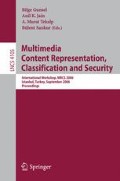Abstract
Recent advances in information security requires strong keys which are randomly generated. Most of the keys are generated by the softwares which use software-based random number generators. However, implementing a True Random Number Generator (TRNG) without using a hardware-supported platform is not reliable. In this paper, a biometric authentication system using a FPGA-based TRNG to produce a private key that encrypts the face template of a person is presented. The designed hardware can easily be mounted on standard or embedded PC via its PCI interface to produce random number keys. Random numbers forming the private key is guaranteed to be true because it passes a two-level randomness test. The randomness test is evaluated first on the hardware then on the PC by applying the full NIST test suite. The whole system implements an AES-based encryption scheme to store the person’s secret safely. Assigning a private key which is generated by our TRNG guarantees a unique and truly random password. The system stores the Wavelet Fourier-Mellin Transform (WFMT) based face features in a database with an index number that might be stored on a smart or glossary card. The objective of this study is to present a practical application integrating any biometric technology with a hardware-implemented TRNG.
Access this chapter
Tax calculation will be finalised at checkout
Purchases are for personal use only
Preview
Unable to display preview. Download preview PDF.
References
Jun, B., Kocher, P.: The Intel Random Number Generator. Cryptography Research, Inc. white paper prepared for Inter Corp. (1999), http://www.cryptography.com/resources/whitepapers/IntelRNG.pdf
Menezes, A., Oorschot, P., van Vanstone, S.: Handbook of Applied Cryptology. CRC Press, Boca Raton (1996)
Schneier, B.: Applied Cryptography, 2nd edn. John Wiley & Sons, Chichester (1996)
Holman, W.T., Connelly, J.A., Downlatabadi, A.B.: An Integrated Analog-Digital Random Noise Source. IEEE Trans. Circuits & Systems I 44(6), 521–528 (1997)
Bagini, V., Bucci, M.: A Design of Reliable True Random Number Generator for Cryptographic Applications. In: Koç, Ç.K., Paar, C. (eds.) CHES 1999. LNCS, vol. 1717, pp. 204–218. Springer, Heidelberg (1999)
Dichtl, M., Janssen, N.: A High Quality Physical Random Number Generator. In: Proc. Sophia Antipolis Forum Microelectronics (SAME), pp. 48–53 (2000)
Petrie, C.S., Connelly, J.A.: Modeling and Simulation of Oscillator-Based Random Number Generators. In: Proc. IEEE Int. Symp. on Circuits & Systems (ISCAS), vol. 4, pp. 324–327 (1996)
Stojanovski, T., Kocarev, L.: Chaos-Based Random Number Generators-Part I: Analysis. IEEE Trans. Circuits & Systems I 48(3), 281–288 (2001)
Delgado-Restituto, M., Medeiro, F., Rodriguez-Vazquez, A.: Nonlinear Switched-current CMOS IC for Random Signal Generation. Electronics Letters 29(25), 2190–2191 (1993)
Yalcin, M.E., Suykens, J.A.K., Vandewalle, J.: True Random Bit Generation from a Double Scroll Attractor. IEEE Trans. on Circuits & Systems I: Fundamental Theory and Applications 51(7), 1395–1404 (2004)
Teoh, A.B.J., Ngo, D.C.L., Goh, A.: Personalised Cryptographic Key Generation Based on FaceHashing. Jour. of Computer & Security (2004)
Von Neumann, J.: Various Techniques Used in Connection With Random Digits. In: Forsythe, G.E. (ed.) National Bureau of Standards. Applied Math. Series, vol. 12, pp. 36–38 (1951)
National Institute of Standard and Technology. A Statistical Test Suite for Random and Pseudo Random Number Generators for Cryptographic Applications. NIST 800-22 (2001), http://csrc.nist.gov/rng/SP800-22b.pdf
Samaria, F., Harter, A.: Parameterisation of a Stochastic Model for Human Face Identification. In: 2nd IEEE Workshop on Applications of Computer Vision, Sarasota FL (December 1994)
Author information
Authors and Affiliations
Editor information
Editors and Affiliations
Rights and permissions
Copyright information
© 2006 Springer-Verlag Berlin Heidelberg
About this paper
Cite this paper
Erat, M., Danışman, K., Ergün, S., Kanak, A. (2006). A Hardware-Implemented Truly Random Key Generator for Secure Biometric Authentication Systems. In: Gunsel, B., Jain, A.K., Tekalp, A.M., Sankur, B. (eds) Multimedia Content Representation, Classification and Security. MRCS 2006. Lecture Notes in Computer Science, vol 4105. Springer, Berlin, Heidelberg. https://doi.org/10.1007/11848035_19
Download citation
DOI: https://doi.org/10.1007/11848035_19
Publisher Name: Springer, Berlin, Heidelberg
Print ISBN: 978-3-540-39392-4
Online ISBN: 978-3-540-39393-1
eBook Packages: Computer ScienceComputer Science (R0)

